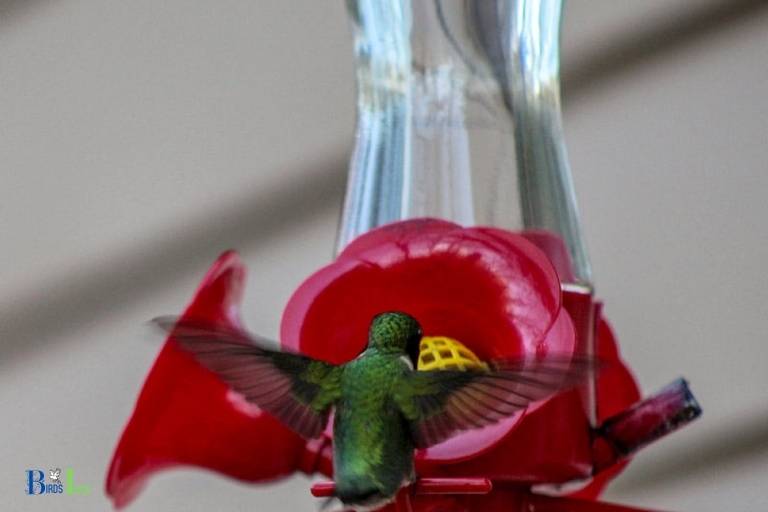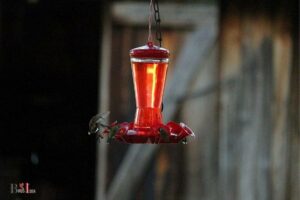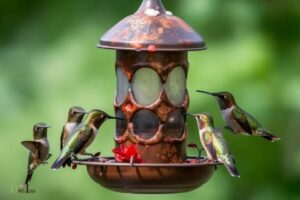How To Prevent Mold In Hummingbird Feeder: 10 Tips!
To prevent mold in a hummingbird feeder, it’s essential to practice regular cleaning and maintenance, alongside other preventive measures.
Mold spores are everywhere and can easily multiply in a hummingbird feeder where sugar-water nectar provides an ideal environment for their growth.
However, preventing mold in your hummingbird feeder is essential for the health and safety of the birds. It can be achieved by taking some easy steps.
Remember, hummingbirds are sensitive creatures. Exposure to mold can make them sick, discouraging them from returning to your yard.
Therefore, it is crucial to ensure the cleanliness of the feeder and the freshness of the nectar.
By maintaining your feeder well, not only will you prevent mold growth but also make your yard a safe and inviting place for these delightful birds.
10 Tips to Prevent Mold In Hummingbird Feeder
| Tips to Prevent Mold in Hummingbird Feeder | Description |
|---|---|
| 1. Clean Regularly | Thoroughly clean and sanitize the feeder at least once a week or more frequently if you notice any mold growth. |
| 2. Use Fresh Nectar | Replace the nectar every 2-3 days to prevent fermentation and mold growth, especially during hot weather. |
| 3. Avoid Direct Sunlight | Place the feeder in a shaded area to prevent the nectar from spoiling quickly, which can lead to mold growth. |
| 4. Choose the Right Feeder Material | Opt for feeders made of glass or high-quality plastic, as they are less likely to develop mold and are easier to clean. |
| 5. Reduce Capacity | Use a smaller feeder or fill it only halfway to ensure the nectar is consumed faster, reducing the chances of mold growth. |
| 6. Proper Feeder Ventilation | Choose a feeder with proper ventilation to prevent the build-up of moisture, which can encourage mold growth. |
| 7. Inspect for Leaks | Regularly check for and fix any leaks in the feeder that can promote the growth of mold and attract unwanted insects. |
| 8. Discard Moldy Nectar | If you find mold in the nectar, discard it immediately and clean the feeder thoroughly before refilling it. |
| 9. Use a Nectar Guard | Use nectar guards or ant moats to prevent ants and other insects from contaminating the nectar, which can lead to mold growth. |
| 10. Rinse with Vinegar Solution | Rinse the feeder with a solution of 1 part white vinegar to 4 parts water to help prevent mold growth during cleaning. |
Key Takeaway

Five Facts About: Prevent Mold In Hummingbird Feeder
Techniques to Prevent Mold Growth in a Hummingbird Feeder
Preventing mold growth in a hummingbird feeder is essential for the health and safety of these delicate birds. Mold can lead to severe health problems for hummingbirds, including infections and respiratory issues.
To prevent mold growth in your feeder, follow these techniques:
- Regularly clean the feeder: Clean the feeder with hot water and a mild detergent at least once a week, more frequently in warmer weather.
- Change nectar frequently: Replace the sugar water every 2-3 days, or as soon as it appears cloudy.
- Use the right sugar-water ratio: A 4:1 water-to-sugar ratio is ideal to prevent fermentation and mold growth.
- Avoid direct sunlight: Place the feeder in a shaded area to minimize temperature fluctuations and slow down mold growth.
- Keep ants away: Use an ant moat or apply food-safe sticky substances around the hanger to prevent ants from reaching the feeder.
By following these preventive measures, you can ensure a clean, safe feeding environment for hummingbirds and enjoy their presence in your garden.
“Mold in hummingbird feeders can be harmful to the birds and lead to serious health problems.”
birdsidea
Reasons for Hummingbird Feeders to Get Moldy
Mold growth in hummingbird feeders is a common issue that arises due to contaminants, moisture, and sugar-water stagnation.
Mold thrives in damp, dark environments, and if feeders are not cleaned and maintained regularly, they become a breeding ground for harmful microorganisms.
Moldy feeders not only pose a serious health risk to hummingbirds but also deter them from returning to your yard.
- Contaminants: Dust, pollen, or bird droppings often find their way into feeders, leading to mold growth.
- Moisture: Excess moisture, especially in humid and damp conditions, accelerates mold formation.
- Sugar-water stagnation: Leaving sugar-water in the feeder for prolonged periods without regular cleaning can promote mold growth.
To prevent mold in hummingbird feeders:
- Clean the feeder regularly with a mild bleach solution, and rinse thoroughly.
- Replace the sugar-water every 2-3 days, even if it appears clean.
- Hang the feeder in a shaded area to minimize direct sunlight exposure, which can speed up mold growth.
Ensure that all feeder parts are completely dry before refilling and reassembling to minimize the risk of mold formation.
Benefits of Regular Maintenance for Hummingbird Feeders
Regular maintenance of hummingbird feeders is essential to prevent mold growth and ensure a healthy environment for the birds.
By cleaning and refilling the feeders frequently, you can avoid the buildup of harmful mold, bacteria, and yeast.
This also helps in attracting more hummingbirds, as they prefer fresh nectar and clean feeders.
Additionally, maintaining your feeders encourages the birds to visit your garden consistently, which in turn helps in pollination and pest control.
- Clean feeders every 2-4 days with a mild detergent
- Use a feeder brush or pipe cleaner to remove any residue
- Completely rinse the feeder to ensure no soap residue remains
- Refill with fresh nectar regularly
- Inspect feeders for any damage or leaks
- Position feeders in shaded areas to reduce nectar spoilage and keep them cool
By following these simple practices, you can enjoy the beauty of hummingbirds in your garden while providing a safe and clean environment for them to thrive.
Best Practices for Keeping a Hummingbird Feeder Free from Mold
Maintaining a clean hummingbird feeder is essential to ensure the health and safety of the birds visiting your garden.
To prevent mold growth, follow these best practices:
- Clean the feeder regularly: At least once a week, clean the feeder with hot water and a mild detergent. Rinse thoroughly to remove any soap residue.
- Replace nectar frequently: Change the nectar every 2-3 days, especially in hot weather, to prevent fermentation and mold growth.
- Avoid direct sunlight: Place the feeder in a shaded area to slow down the spoilage of nectar.
- Use a brush and vinegar: A bottle brush or an old toothbrush and a mix of water and white vinegar can help remove mold spots effectively.
- Check for leaks and cracks: Regularly inspect your feeder for any damage that could lead to the accumulation of moisture and mold.
By incorporating these practices, you can provide a healthy and enjoyable feeding environment for hummingbirds.
According to the Cornell Lab of Ornithology, over 30% of hummingbirds die within their first year of life, often due to disease and parasites. Keeping their feeders clean and mold-free is essential to their health and survival.
birdsidea
How can I keep mold out of my hummingbird feeder?
Hummingbird feeders can be a breeding ground for mold which is not only unsightly but can be harmful to your feathered friends.
To keep mold out of your hummingbird feeder, try out these simple steps:
- Clean the feeder regularly – make sure to clean the feeder thoroughly every few days to prevent mold from growing.
- Use the right ratio of sugar water – a mixture of four parts water to one part sugar is perfect for the hummingbirds and leaves no excess sugar for mold growth.
- Store the feeder in a cool location – keeping the feeder in direct sunlight can cause the sugar water to spoil and mold to grow.
- Use a natural nectar protector – many natural nectar protectors contain ingredients such as vinegar or citric acid that help to inhibit mold growth.
By following these steps, you can help keep mold out of your hummingbird feeder and provide a safe and healthy environment for your feathered friends to visit.
Is mold bad for hummingbirds?
Hummingbirds are delicate creatures that require a clean and safe feeding environment. If mold growth occurs in their feeding station, it can pose a potential health risk to these tiny birds.
Here are some reasons why mold can be bad for hummingbirds:
- Mold can cause respiratory issues in hummingbirds, leading to breathing difficulties and other health problems.
- When mold and bacteria grow in a hummingbird feeder, it can contaminate the nectar and reduce the nutritional value for the birds.
- Hummingbirds may become sick or die if they consume contaminated nectar.
To prevent mold growth in a hummingbird feeder and keep these feathered visitors healthy, regular cleaning and maintenance are essential.
Clean the feeder thoroughly every 3-4 days and replace the nectar every 2-3 days to prevent mold growth.
Use a solution of one part white vinegar and four parts warm water to clean the feeder and rinse it thoroughly with clean water before refilling it with fresh nectar.
By maintaining a clean and well-maintained feeding station, you can ensure that your hummingbirds will continue to visit and delight you with their vibrant presence.
How do you sterilize hummingbird feeders?
Hummingbird feeders can easily become contaminated if not cleaned and sterilized regularly. Cleaning and sterilizing hummingbird feeders is a crucial part of maintaining a healthy feeding station for these tiny birds.
Here’s how you can sterilize your hummingbird feeders:
- Disassemble the feeder carefully so that you can access all parts easily.
- Wash all parts thoroughly with hot, soapy water.
- Rinse the parts with hot water to remove any soap residue.
- Soak all parts in a solution of one-part white vinegar to four parts hot water for at least an hour.
- Rinse thoroughly with hot water and allow the parts to air dry.
Sterilizing your hummingbird feeder periodically not only prevents the growth of harmful bacteria but also helps keep the nectar fresh and tasty for the birds.
Plus, it’s a simple step that takes just a few minutes and ensures the well-being of your feathered visitors.
How often should I clean my hummingbird feeder?
Cleaning your hummingbird feeder is important to keep it free from mold, bacteria, and other contaminants that could harm the birds. If you don’t clean it often enough, the nectar can spoil and make the birds sick.
Here are some guidelines for how often to clean your hummingbird feeder:
- In warmer weather: Clean your feeder every 2-3 days to prevent the growth of mold and bacteria.
- In cooler weather: Clean your feeder every week or so, as the nectar won’t spoil as quickly.
If you notice any mold or other contaminants in your feeder, clean it immediately to prevent harm to the birds.
To clean the feeder, simply empty the nectar, rinse the feeder with warm soapy water, scrub off any residue or mold, and rinse it again with water. Refill with fresh nectar and you’re ready for your feathered visitors!
How do you clean bird feeders with vinegar?
If you are looking for a natural and effective way to clean your bird feeders, vinegar is the way to go.
Follow these simple steps to clean your bird feeders with vinegar:
Take the feeder apart: Disassemble the bird feeder and remove all the parts and accessories.
Soak In Vinegar Solution: Mix equal parts of white vinegar and water in a large bowl or bucket. Place the feeder parts in the solution and allow them to soak for an hour.
Scrub and Rinse: Scrub the feeder components with a brush to remove any debris or residue. Rinse the parts with water until all the traces of vinegar solution are removed.
Let Dry: Allow the feeder to completely dry before reassembling it.
Benefits of Using Vinegar to Clean Bird Feeders:
- Vinegar is non-toxic and eco-friendly, making it safe for the environment and birds.
- It is readily available and inexpensive.
- Vinegar is a natural disinfectant and helps to kill off harmful bacteria and germs.
- Using vinegar regularly can help to extend the lifespan of your bird feeders by preventing mold growth and keeping them clean.
Where’s the best place to put a hummingbird feeder?
The best place to put a hummingbird feeder is an important consideration to ensure the birds will come and enjoy the food.
Here are some ideal locations to place your hummingbird feeder:
- Near flowers and plants: Hummingbirds love to feed on nectar from flowers, so placing the feeder near blooming flowers can attract them.
- Away from predators: Place the feeder in a safe zone where cats, squirrels, and other predators cannot climb or reach it.
- In the shade: Hummingbirds prefer their nectar fresh and cool. Placing the feeder in a shaded area can help to keep it fresh and prevent the nectar from spoiling too quickly.
- Visible from a window: Hang the feeder in a place where it can be easily seen from inside the house, so you can enjoy watching the birds from the comfort of your home.
Be sure to clean the feeder on a regular basis to avoid contamination and harmful mold growth. Use a mild soap and warm water to clean the feeder thoroughly at least once a week.
FAQ for How To Prevent Mold In Hummingbird Feeder
How often should I clean my hummingbird feeder?
What is the best way to clean a hummingbird feeder?
How can I prevent mold from growing in my hummingbird feeder?
How often should I replace the nectar in my hummingbird feeder?
Conclusion
In conclusion, preventing mold growth in a hummingbird feeder is crucial for the safety and health of the birds.
Regular maintenance, such as cleaning and disinfecting the feeder, is essential to prevent mold from forming. Additionally, using proper techniques like using white vinegar or a bleach solution can also help in preventing mold growth.
It is important to keep in mind that the reasons for mold growth in a feeder can vary, but taking preventive measures can help ensure the longevity of the feeder and the safety of the hummingbirds.
By following these best practices, you can maintain a clean and mold-free hummingbird feeder for the enjoyment of these beautiful creatures.






